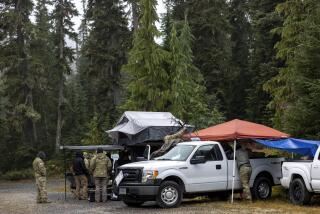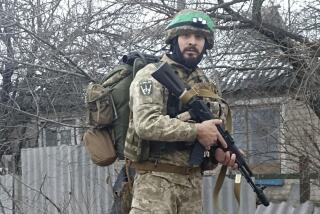Bodies of 2 Servicemen Leave Colombia for U.S.
- Share via
BOGOTA, Colombia — A lone bugler sounded out a solemn last lament Friday at an air base in Bogota as U.S. Marines and Colombian airmen paid tribute to two of the American service personnel who died in a plane crash in southern Colombia last week.
Their coffins, draped with the Stars and Stripes, were loaded aboard a Hercules transport plane, destined for the Americans’ home base of Ft. Bliss, Texas.
Five U.S. military personnel and two Colombian air force majors died when the U.S. De Havilland RC-7 reconnaissance plane slammed into a mountain during a counter-narcotics mission over rebel-occupied Putumayo province last Friday.
They were believed to be the first U.S. troops to be killed in the history of Colombia’s U.S.-backed war against spiraling cocaine and heroin production.
The corpses of two of the other Americans remained in Bogota, the capital, while rescuers scoured the crash site, 7,000 feet up a mountainside, Friday for the bodies of a fifth American and the two Colombians.
Partial remains were recovered from the area late Thursday, but authorities said they had not yet been identified.
Neither Colombian nor U.S. officials made any public comments Friday during the brief ceremony at the Catam air force base on the edge of Bogota.
The De Havilland, equipped with sophisticated infrared imaging, heat-seeking and eavesdropping apparatus, disappeared off radar over a region rife with illegal drug plantations. The area also is a stronghold of the Revolutionary Armed Forces of Colombia, or FARC, guerrillas.
Earlier this week, U.S. Ambassador Curtis Kamman blamed the accident on navigation problems. There is no suggestion that FARC rebels, fiercely opposed to Washington’s anti-drug policy, had a hand in downing the aircraft.
None of the Americans--two captains, a warrant officer and two enlisted men--have been formally identified.
During the past 2 1/2 years, at least three U.S. civilian pilots have died when their crop-duster planes crashed during operations to spray herbicides on plantations of coca leaf, from which cocaine is made.
Leftist rebels frequently fire at anti-drug planes and helicopter gunships flying over drug plantations but rarely manage to shoot them down.
Last Friday’s crash reawakened suspicions that Washington is carrying out high-tech intelligence-gathering operations against the guerrillas.
During a three-day visit to Colombia this week, White House anti-drug director Gen. Barry R. McCaffrey said he no longer believes that there is a dividing line between counter-narcotics and counterinsurgency operations, given the growing links between the rebels and the drug trade.
He has, however, ruled out any front-line role for U.S. personnel in anti-guerrilla operations.
More to Read
Sign up for Essential California
The most important California stories and recommendations in your inbox every morning.
You may occasionally receive promotional content from the Los Angeles Times.










